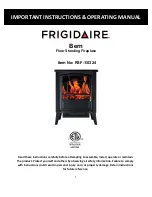
Getting To Know Your Stove
Please familiarise yourself with the features of your
Ignis stove:
Operating Your Stove
Using Your Stove for the First Few Times
• The first 3 or 4 fires should be small, allowing the
stove to operate at a low temperature and allow
the paint and fire cement to cure gently. This
will prolong the finish and the integrity of the fire
cement seals.
• It is important to note that there may be an
unpleasant odour from the first few fires. This is
nothing to be alarmed about, it is just part of the
curing process. Keep the room well ventilated to
avoid the build-up of fumes.
Lighting Your Stove
• Open the air wash vent approximately 50%.
• Place fire lighters or loose paper in the grate and
put dry kindling on top.
• Light the fire lighters or paper.
• Leave the door slightly open as the fire establishes
and the stove warms, this will prevent condensation
on the glass doors.
• Never leave a lit stove unattended with the door
open.
• Close the stove door as soon as possible while the
fire warms and builds.
• As the fire establishes, add small pieces of wood,
do not add so much that it entirely fills stove, make
sure that it does not displace or come into contact
with the brick baffle plate. Avoid adding too much
fuel as this will smother the fire-do not fill above
clean burn vents.
• The cleanburn vent is controlled by a lever on the
side of the stove - push the lever in towards the
stove to open and pull out away from the stove to
close. Opening the lever will allow a second chance
for any unburned gasses from the fuel to ignite
thereby giving a cleaner burn.
• The lever can be left open (in) at all times, but may
be adjusted depending on the chimney draught.
Primary Vent Control
• Open the primary air vent to feed in extra air to
revive a failing fire or to accelerate the burn.
• Operate with the primary air vent open when
burning coal.
• Adjust the primary air vent to achieve a controlled
burn rate while burning cleanly.
Running the Stove
• Burn only dry, well-seasoned wood that is cut and
dried for at least a year. We recommend that you
use a Valiant Moisture Meter to test and ensure
that wood fuel contains less than 20% moisture
content.
• We advise that you burn your stove at high output
for at least 30 minutes each time it is used to avoid
the excessive build-up of tar and creosote in the
stove and flue system.
• Use a Valiant Stove Thermometer to measure the
temperature of the stove and monitor the optimum
operating burn rate. Place the thermometer on
either side of the stove, near the top and close to
the front of the stove. The temperature of the stove
in normal operation will sit within the red (burn)
zone.
• Certain conditions may require increased airflow
when initially lighting the stove, this can be done
by adjusting the both levers (Air Wash lever and the
Primary lever).
• Do not operate the stove with the door open.
• Do not operate the stove with baffle or firebricks
removed.
• For best results leave a small bed of ash in the
stove when burning wood.
• Coal: Burn only good quality household coal and
smokeless briquettes. If in doubt refer to the HETAS
website.
Cleanburn
Vent Control
Air Wash Vent
Primary Vent
Note: on DEFRA approved stoves the airwash vent
is limited to ensure optimum burn charactaristics,
reduced smoke and particulate emission to the
environment.




























